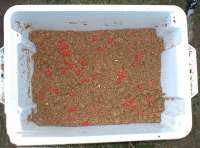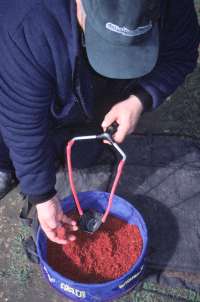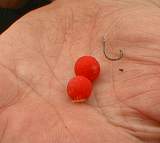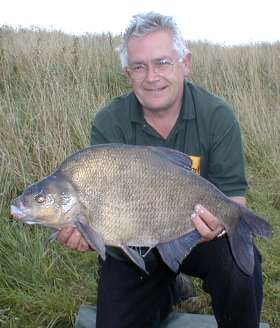Neil Wayte wrote: “Graham I would be grateful for your thoughts on this subject (bream groundbait),bearing in mind it must be catapulted out. ” And added, “I’m tryingto be as cost-effective as possible. I intend to use huge amountsbecause there are some huge shoals of doubles in the water. I’vefished for them previously but had trouble with my groundbaitbreaking up. The base is Vitalin which I think is too coarse forbream, although it’s okay for carp.”
And this was followed up by JohnConway, who wrote: “Neil and Graham, I would also like to hearyour thoughts on this subject of groundbaiting for bream as this willbe my target species this year…….. I would very much liketo mix my own groundbait and experiment with flavoured bread flake. Iwould also be grateful for any advice on mixing bread flake into myground bait so that it all stays intact for a forty-metrethrow.”
|
|
| maggots when catapulting) |
Vitalin, a dog food made from various cereals, vitamins, etc, isgreat for carp but I reckon that, like Neil suspected, it’s toocoarse and probably too rich for bream. What you need for bream issomething that will hold them in the swim but not feed them very muchat all; something that will make them work for what little feedingthey do manage to achieve. This is assuming that a spot along a knownbream feeding route has been chosen. That is the essential element ofbream fishing, as it is with most species. But where bream areconcerned it is important to fish the route they usually patrol on adaily basis, except when the conditions are so dire they don’t movehardly at all.
The Ingredients and how to mix them
I usually use plain brown and white 40/40, 10% Van den Eynde Expo,and 10% crushed hemp. Hemp isn’t a favourite bream flavour butcrushed hemp helps the mix to explode on the bottom. The water I usefor the mix has a rich dose of molasses in it. I never measure that,just enough so that there is plenty in it. Bream love sweet baits andyou can’t overdo it.
|
|
| |
It’s how you mix the groundbait that matters as much as whatyou’re mixing. Use a wide container rather than a deep one, ie, ashallow bowl. Mix the dry ingredients and then slowly trickle themolasses water in preferably using a sponge or a spray, all the timestirring the bait, turning it over and over and getting plenty of airinto it, with the aim of ending up with a mix that is firm enough tocatapult without breaking up but will begin to break up and explodeas soon as it hits the water’s surface, spreading bait particles asit sinks.
You can, of course, lace the mix with hookbait samples, anythingexcept very lively things like maggots and full worms which willbreak the ball up in flight. Chopped worms, caster, feeder maggotsand a few pinkies are all okay. Add flake by breaking pieces offwhich are roughly the same size as the hookbait you intend using,squeeze the air out of it, and then simply poke these into thegroundbait ball before firing it in. When the groundbait breaks up itwill release the flake which won’t float to the surface if you’vesqueezed the air out of it, but will swell and look like a hookbaitafter a minute or two.
|
|
| ready for the catapult |
Other things that can be added to bream groundbait, especiallywhen large quantities are required and you’re on a budget, are wheat,groats and rice. In fact, one of my favourite additives iswell-soaked groats which produces a milky juice and a nice cloud inthe water. The addition of trout or carp pellets, a littleflavouring, betaine, or other enhancer to give the groundbait yourunique label won’t do any harm either.
Many bream waters these days are also carp waters. In fact they’reusually predominantly carp waters, which means that boilies will beat the top of the menu. Bream are no different than any other speciesin that they will come to love these highly nutritious baits aboveall else. In that case a good lacing of broken and crushed boilies isa must for adding to the groundbait.
Which hookbait?
|
|
| |
If boilies are the chosen hookbait then I prefer two hair-rigged10mm boilies for bream rather than a single larger one. And the oneflavour I have done best on for bream is Richworth’s Esterberry. Butno boilie flavours are written in stone, the bream will takeanything, especially the flavour that is being used most.
On waters which are not recognised carp waters and therefore notbeing baited too often with boilies there is still nothing to beatworm, bread flake, caster and maggot for hookbaits. A couple ofredworms or a lob tail on a 12’s, or a full lob or a pinch of flakeon an 8’s will usually sort them out. And when you can feed the swimwith a lot of loose feed such as caster and maggot then two to fourmaggots or casters on a 14’s should do the trick.
Of course there are plenty of other baits that catch bream, suchas sweetcorn, pellets, luncheon meat, oh, all kinds of things. Itcould be any one of those the bream on your water will prefer. Alwaysexperiment with that second rod, you never know when you’ll discoversomething that works better than the usual.
|
|
| |
To conclude
I must point out though, that given the opportunity, I wouldalways prefer to bait my bream swims from a boat, using either anordinary rowing boat or a baitboat. That way you can mix thegroundbait much drier and allow it to sink in a big cloud thatspreads evenly over the bottom. Particle baits, including maggot andcaster, can also be scattered evenly over the baited area. Theemphasis can be placed on particles rather than groundbait, forparticles are a much better holding bait.
Something else the modern bream angler should have at his disposalis a spod and a spod rod. Where you can’t use a boat you can spod theparticle out. Okay, you don’t get the same even spread you can with aboat, but it’s the next best thing.
Also, The Method is another technique that should beconsidered.
Hope that helps Neil, John, and anyone else who fancies a go at these often very difficult fish.
Any more questions on this topic please post here, to the originalthread: ‘Bream Groundbait’.















